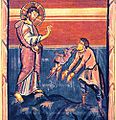Hitda Codex
- View a machine-translated version of the German article.
- Machine translation, like DeepL or Google Translate, is a useful starting point for translations, but translators must revise errors as necessary and confirm that the translation is accurate, rather than simply copy-pasting machine-translated text into the English Wikipedia.
- Consider adding a topic to this template: there are already 9,148 articles in the main category, and specifying
|topic=will aid in categorization. - Do not translate text that appears unreliable or low-quality. If possible, verify the text with references provided in the foreign-language article.
- You must provide copyright attribution in the edit summary accompanying your translation by providing an interlanguage link to the source of your translation. A model attribution edit summary is
Content in this edit is translated from the existing German Wikipedia article at [[:de:Hitda-Codex]]; see its history for attribution. - You may also add the template
{{Translated|de|Hitda-Codex}}to the talk page. - For more guidance, see Wikipedia:Translation.
The Hitda Codex is an eleventh-century codex containing an evangeliary, a selection of passages from the Gospels, commissioned by Hitda, abbess of Meschede in about 1020. It is held at University and State Library Darmstadt.[1] Hitda is depicted in the book's dedication miniature presenting the codex to the convent's patron, Saint Walburga. St. Walburga stands on a pedestal in the center of the composition, and has a golden halo surrounding her head. Behind the two women is the monastery that Hitda oversees, which fills the entire background.[2]
The illuminations are highlights of the Cologne school in the later phases of the Ottonian Renaissance. The Hitda Codex contains the only surviving Life of Christ cycle of illuminations produced in Cologne from this period.[3] The cycle's cultural context has been replicated by Henry Mayr-Harting.[4]
Gallery
-
 The Healing of St Peter's mother-in-law
The Healing of St Peter's mother-in-law -
 Healing of the demon-possessed
Healing of the demon-possessed -
 Dedication miniature
Dedication miniature -
 Healing of a man with a withered hand
Healing of a man with a withered hand -

-

-
 Christ in Majesty
Christ in Majesty -
 Baptism of Christ
Baptism of Christ -
 Annunciation
Annunciation -
 Calming the storm
Calming the storm
Notes

- ^ Hessische Landesbibliothek, MS 1640.
- ^ Stokstad, Marilyn (2004). Medieval Art. Colorado: Westview Press. p. 179.
- ^ Noted by R. Schilling, reviewing the exhibition of Carolingian and Ottonian illuminated manuscripts at the Kunstmuseum Berne, in The Burlington Magazine, 92 No. 564 (March 1950:82.
- ^ Henry Mayr-Harting, Ottonian Book Illumination. Part One: Themes. Part Two: Books, sect. III, London, 1991.



















